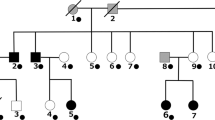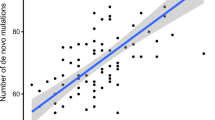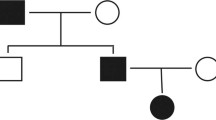Abstract
Recently, we cloned the human myo-inositol monophosphatase 2 (IMPA2) cDNA and established its map location to chromosome 18p11.2, a region previously implicated in bipolar disorder. Because the myo-inositol monophosphatase enzyme has been shown to be inhibited by lithium, an effective therapeutic agent for bipolar disorder, IMPA2 is a plausible positional and functional candidate gene. To permit comprehensive screening for variants we characterized the genomic structure and isolated the potential promoter of IMPA2. The gene was found to encode eight exons spanning ˜27 kb. The proximal 1-kb 5′ flanking region did not contain an obvious TATA box but multiple potential binding sites for Sp1 and consensus motifs for AP2 and other transcription factors were evident. Sequencing of the coding region and splice junctions in unrelated bipolar disorder patients detected novel variants. A missense mutation in exon 2, His76Tyr, was found in one patient. His76 is evolutionarily conserved and replacement with Tyr introduces a potential site for phosphorylation. The other polymorphisms included an Rsai polymorphism, ivs1-15g>A, and a T → C silent mutation in the third nucleotide of codon 53 in exon 2. By Fisher's exact test the silent mutation showed a trend for association (P = 0.051) with bipolar disorder suggesting that further scrutiny of this gene is warranted.
This is a preview of subscription content, access via your institution
Access options
Subscribe to this journal
Receive 12 print issues and online access
$259.00 per year
only $21.58 per issue
Buy this article
- Purchase on Springer Link
- Instant access to full article PDF
Prices may be subject to local taxes which are calculated during checkout




Similar content being viewed by others
References
Berrettini WH, Ferraro TN, Goldin LR, Weeks DE, Detera-Wadleigh SD, Nurnberger Jr JI et al. Chromosome 18 DNA markers and manic-depressive illness: evidence for a susceptibility gene Proc Natl Acad Sci USA 1994; 91: 5918–5921
Detera-Wadleigh SD, Badner JA, Berrettini WH, Yoshikawa T, Goldin LR, Turner G et al. A high density genome scan detects evidence for a bipolar-disorder susceptibility locus on chromosome 13q32, and other potential loci on 1q32 and 18p11.2 Proc Natl Acad Sci USA 1999; 96: 5604–5609
Stine OC, Xu J, Koskela R, McMahon FJ, Gschwend M, Friddle C et al. Evidence for linkage of bipolar disorder to chromosome 18 with a parent-of-origin effect Am J Hum Genet 1995; 57: 1384–1394
Nothen MM, Cichon S, Rohleder H, Hemmer S, Franzek E, Fritze J et al. Evaluation of linkage of bipolar affective disorder to chromosome 18 marker in a sample of 57 German families Mol Psychiatry 1999; 4: 76–84
Yoshikawa T, Turner G, Esterling LE, Sanders AR, Detera-Wadleigh SD . A novel human myo-inositol monophosphatase gene, IMP. 18p, maps to a susceptibility region for bipolar disorder Mol Psychiatry 1997; 2: 393–397
Sjoholt G, Molven A, Lovlie R, Wilcox A, Sikela JM, Steen VM . Genomic structure and chromosomal localization of human myo-inositol monophosphatase gene (IMPA) Genomics 1997; 45: 113–122
Parthasarathy L, Vandal RE, Parthasarathy R, Devi CSS . Biochemical and molecular properties of lithium-sensitive myo-inositol monophosphatase Life Sci 1994; 54: 1127–1142
Atack JR . Inositol monophosphatase, the putative therapeutic target for lithium Brain Res Rev 1996; 22: 183–190
NIMH Collaborative Group for Bipolar Disorder: Nurnberger JI Jr, DePaulo JR, Gershon ES, Reich T, Blehar M, Edenberg H, et al. A genomic survey of bipolar illness in the NIMH Genetics Initiative Pedigrees: a preliminary report Am J Med Genet 1997; 74: 227–237
Neuwald AF, York JD, Majerus PW . Diverse proteins homologous to inositol monophosphatase FEBS Lett 1991; 294: 16–18
Azizkhan JC, Jensen DE, Pierce AJ, Wade M . Transcription from TATA-less promoters: dihydrofolate reductase as a model Crit Rev Eukaryotic Gene Expression 1993; 3: 229–254
Dynan WS, Tjian R . Control of eukaryotic messenger RNA synthesis by sequence specific DNA binding proteins Nature 1985; 316: 774–778
Kadonaga JT, Jones KA, Tjian R . Promoter specific activation of RNA polymerase II transcription by Sp1 Trends Biochem Sci 1986; 11: 20–23
Blake MC, Jambou RC, Swick AG, Kahn JW, Clifford J, Azizkhan JC . Transcriptional initiation is controlled by upstream GC-box interaction in a TATA-less promoter Mol Cell Biol 1990; 10: 6632–6641
Olson EN . MyoD family: a paradigm for development? Genes Dev 1990; 4: 1454–1461
Imagawa M, Chiu R, Karin M . Transcription factor AP-2 mediates induction by two different signal-transcription pathways: protein kinase C and cAMP Cell 1987; 51: 251–260
Schwab SG, Hallmayer J, Lerer B, Albus M, Borrmann M, Honig S et al. Support for a chromosome 18p locus conferring susceptibility to functional psychoses in families with schizophrenia, by association and linkage analysis Am J Hum Genet 1998; 63: 1139–1152
Acknowledgements
We thank Dr Elliot S Gershon for diagnosis of the families, Lori Oosterbahn for her assistance in isolating the cosmid clones, and Gordon Turner and Tracy Moses for their help in sequencing.
Author information
Authors and Affiliations
Corresponding author
Additional information
The sequences determined in this study are deposited in the GenBank under the accession numbers of AF025878 through AF025886
Rights and permissions
About this article
Cite this article
Yoshikawa, T., Padigaru, M., Karkera, J. et al. Genomic structure and novel variants of myo-inositol monophosphatase 2 (IMPA2). Mol Psychiatry 5, 165–171 (2000). https://doi.org/10.1038/sj.mp.4000688
Received:
Revised:
Accepted:
Published:
Issue Date:
DOI: https://doi.org/10.1038/sj.mp.4000688



